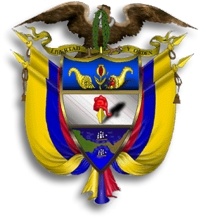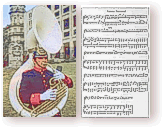
 |
||
THE FLAG
Colombia's flag was created on March 12, 1807 by Francisco Miranda, an important figure leading up to the fight for independence. The yellow, blue and red striped flag flew for the first time on his schooner, Leandro.
"The flag and banner of the Republic of Colombia is composed of red, blue, and yellow colours in three horizontal stripes, of which the yellow one, placed in the upper part, has a width equal to half the flag, and the other two stripes each have a width equal to one quarter of the total, with the blue one in the middle".
Some historians believe that the red and yellow colours were taken from the Spanish flag and the blue one represented the colour of the sea that separated the new territory from Spain. Other historians think that the colours symbolize the Code of Arms that Spain gave to Christopher Columbus. The background of the four sections into which the Spanish Code of Arms is divided, corresponds exactly to the colours chosen by Miranda. The current meaning of the colours: |
|
||||||||||||||||||||||||||
 LIBERTAD Y ORDEN |
COAT OF ARMS The Coat of Arms was introduced on May 9th,1834. The coat of arms is in the shape of a shield (Swiss form) and is 6 parts wide by 8 parts high. It is divided into three distinct horizontal sections. The upper section, on a blue field, has in its centre an open gold pomegranate with red grains inside, a golden stem and leaves. On each side of the pomegranate there is a recumbent golden cornucopia, the one on the left pouring coins toward the pomegranate, and the one on the right full of tropical fruits. The pomegranate (granada) denotes the name of the country at the time the coat of arms was introduced (La Nueva Granada) and the cornucopias symbolize the wealth of the land, its minerals and the rich soils of the tropical zone. The middle section shows a Phrygian cap (the symbol of freedom) on a platinum field (a Colombian precious metal). The lower section shows the Panamanian Isthmus separating the two adjacent silver seas, with a black ship, sails unfurled, on each of them. The Isthmus no longer belongs to Colombia. The condor, representing freedom, perches at the top of the coat of arms. Hanging from its beak is a laurel wreath, intertwined with a golden waved ribbon tied to the emblem. The words "Libertad y Orden" (Freedom and Order) are written in black on the ribbon. Four tilted lances rise from the sides of the coat of arms, two on the right and two on the left, from which hang four Colombian flags which surround the emblem. The flags are bound together at the bottom tip of the shield. |
||||||||||||||||||||||||||
 NATIONAL ANTHEM NATIONAL ANTHEM The National Anthem of the Republic of Colombia was first sung in public on November 11, 1887 in a small theatre at the Cathedral Public School.Its official inauguration took place the following month, on December 6,1887, at the Graduation Hall in front of the Palace of San Carlos. Doctor Rafael Núñez, President of the Republic, attended this ceremony, as well as military, ecclesiastical and civil authorities, ministers and members of the Diplomatic Corps. See more ... |
|||||||||||||||||||||||||||
|
|||||||||||||||||||||||||||
|